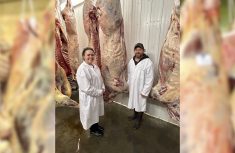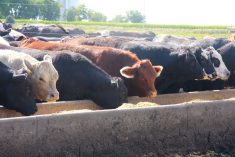For Jay Cross of Bar Pipe Hereford Ranch, Expected Progeny Differences (EPDs) play a significant role in breeding functional cattle. “Particularly in the last 10 years, we have recognized that an increasing number of our customers are driven by EPDs,” says Cross, who ranches at Okotoks, Alta. The Hereford breeder, whose family has raised cattle since the 1880s, targets his herd of approximately 200 purebred females to meet the needs of commercial producers.
While not all of his customers are focused on EPDs, Cross notes that this technology, along with genomic testing, assists in selecting traits to benefit buyers. “The idea is that we’re raising our cattle and selecting our cattle under conditions that mimic the vast majority of our commercial customers,” he continues.
Read Also

Farm families work together to graze cropland with cattle in the fall
These Alberta farm families have separate operations, but work together to manage their land
It comes as no surprise, then, that Cross is among the many Canadian beef producers considering the implications of a new method for calculating EPDs. Biometric Open Language Tools (BOLT) is a software for running single-step genetic evaluations, soon to be used by a number of Canadian breed associations.
The primary difference between BOLT and other methods is how it incorporates DNA directly into EPD calculations. Developed by Dr. Bruce Golden and Dr. Dorian Garrick of Theta Solutions, BOLT calculates EPDs using pedigree, performance data and DNA results at once. In previous models, EPDs were calculated with just pedigree and performance data, then adjusted based on DNA information.
With BOLT, an animal’s genomic data will be incorporated throughout its pedigree, affecting the evaluations of its ancestors and progeny. “If there’s 3,000 markers that impact weaning weight, it will include the influence of each of those markers, so it’s a lot more powerful evaluation technology than what we’ve used in the past,” says Sean McGrath, breed improvement specialist with the Canadian Simmental Association (CSA).
BOLT allows for more frequent evaluations due to its computing power, providing a faster turnaround on updated EPDs. “If you collect a yearling weight on your bulls a month before your bull sale, you should have EPDs for your bull sale that reflect that data,” says McGrath.
This new technology promises truer genetic evaluations, but this also raises concerns about animals being reranked. McGrath notes that possible changes to rankings relate to the role of DNA in the single-step model. “The BOLT system, using a 50K DNA test, is equivalent to 22 progeny records,” he says. “The added 22 calves’ worth of data to a young bull could change quite a bit what you think of him.”
Accuracies may also change with this model, but McGrath explains that these possibly lower accuracies are better than those estimated through the previous methodology. “In the BOLT system, accuracy is calculated directly, mathematically, but as a result, the expression of that accuracy has gone down. The evaluation is better, but the way we express accuracy is a little bit lower.”
A major advantage of BOLT is improved risk management, particularly in selecting younger animals. For example, while it previously took years to know if a sire produced long-lived daughters, BOLT promises better predictions on yearling bulls. “If you can buy a virgin bull where you’ve already got as much information on him as if he’d had 15 or 20 calves, that’s a pretty good risk-management tool,” says McGrath.
Many breeds transitioning to BOLT
The Canadian Angus Association uses IGS for Red Angus EPDs, and will soon calculate them with BOLT. Black Angus cattle registered with the association, however, are evaluated with a different single-step method at Angus Genetics, Inc. (AGI).
The Canadian Charolais Association plans to use a different single-step methodology at AGI, and the Canadian Maine-Anjou Association is not using BOLT at this time.
The Canadian Hereford Association (CHA) also transitioned to BOLT, with its first run published in December. The only traits not included are the feedlot merit and maternal productivity indexes, as necessary updates have yet to be completed, says CHA general manager Stephen Scott.
Along with the American, Argentinian and Uruguayan Hereford associations, the CHA is part of the Pan-American Cattle Evaluation. Currently, the Canadian and American associations use BOLT, with Argentina and Uruguay transitioning to this model this summer.
The CHA now has weekly runs with BOLT, allowing for better return on the members’ investment in DNA testing. “If breeders are paying good money to get these cattle tested, we want that information back to them as quick as possible, so this is the quickest turnaround we can do with genomics,” says Scott. “As soon as it’s done at the lab, it goes in the next extract and will be published within two weeks.”
Developing new tools
The CSA has introduced a new stayability trait using BOLT in conjunction with the American Simmental Association. Previously, both associations scored this on a success/failure model based on whether a cow reached the age of six. The new model gives credit based on the age of the animal, which McGrath calls a better reflection of longevity in herds.
Similarly, the CHA has adopted a new trait called sustained cow fertility, measuring a female’s ability to stay in a herd up to the age of 12 with a calf each year. Hereford breeders will also see new traits to score udder suspension and teat length.
BOLT powers the IGS Feeder Profit Calculator, a free marketing tool introduced in the summer of 2017. This uses sire information as well as details on weaning and health management to predict the potential profit on a group of feeder calves.
After submitting this information, producers receive a Feeder Profit Calculator certificate, which provides a breakdown of the total relative value of the calves. This is a combination of two measurements: relative genetic value, a predicted difference in value between the calves in question and a similarly managed group of average Angus calves, based on genetic merit; and relative management value, a predicted difference in value based on management details.
“The feedback has been phenomenal from all facets of the industry,” says Chip Kemp, director of membership and industry operations at IGS. “Producers have been eager to highlight their calves and to take the knowledge they are gaining back home to refine their own processes and decision-making.” As of January, Kemp reports that about 100 loads of calves have been evaluated using the calculator.
Practical benefits and challenges
“For most of the breeds that are participating in IGS, it’s their individual breed’s decision when or how they want to release the EPDs that come out of the BOLT system, but most of them are targeting mid- to late summer through fall of 2018,” says McGrath.
In other words, producers can expect to see any changes in EPDs of the IGS breeds reflected in next year’s bull sale catalogues.
McGrath notes that while he sees this as a positive initiative, the power of this technology requires producers to have a better idea of what they want. “We can change (cattle) quicker because we can select young bulls and do certain things a lot more accurately than we could in the past,” he explains. “We can change them more quickly in the wrong direction… if we don’t have a plan.”
While Cross supports the CHA’s use of BOLT, he anticipates challenges in adjusting to changes in accuracies and more frequently updated EPDs. “We’re used to seeing an EPD that’s published in an ad or in a catalogue, and if they’re changing every month, the big caveat will be that the EPD at time of publication might be changed, and that’s likely to frustrate people.”
Despite this, he believes that breeders need to be patient in adapting to these changes. “Everybody just has to take a deep breath and remember that if they’re changing over time, it’s because they’re becoming more accurate,” he says. “There’s going to be some adjustments, but I think overall it’s very positive. To have more rapid refinement of the EPD profiles can only be a good thing.”
Cross also views this as an advantage for international sales, given the amount of trade in genetics between Canada and the United States. “If the American associations are making this shift, we really needed to make this shift,” he says. “The American breed associations are moving fairly quickly and therefore gives us an opportunity to move fairly quickly as well.”
Bill Campbell of Campbell Limousin at Minto, Man., is also mindful of the implications of BOLT in selecting quality cattle. Campbell, who has served as president of the Canadian Limousin Association, is now part of its BOLT review committee. “I think the positives far outweigh the negatives, so I’m eager to see how it will evolve,” says Campbell, whose herd currently consists of 70 head of purebred females.
Campbell agrees that education will likely be an early challenge, but higher-accuracy information, weekly evaluations and benefits such as including embryo transfer calves in evaluations are worth it. “I think that will be a great advantage to the industry, that we will have the most current available numbers,” he explains. “It will take a bit of a learning curve, because your pedigree from last fall with the EPDs printed on it won’t necessarily be the same as what they are this spring.”
As well, Campbell predicts benefits for his herd and the Limousin breed in regards to more accurate information on younger, unproven cattle. “We will be able to make better management decisions when we breed those heifers,” he says. “Any introduction of a new program takes some acceptance and the time to understand it, but if we can increase the accuracy and the trustworthiness of the EPD and the genetic selection, I think it’s a positive move.”

















